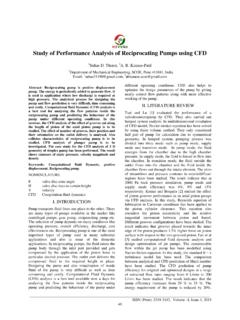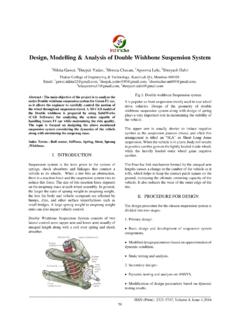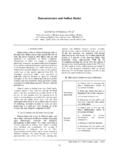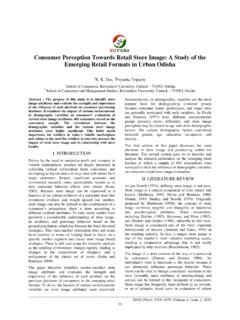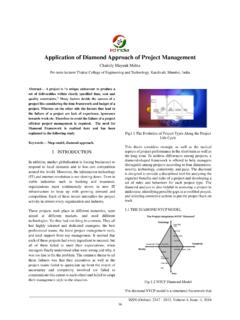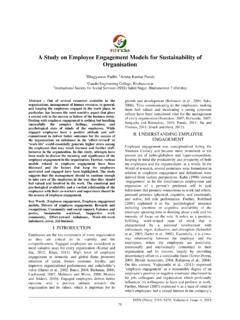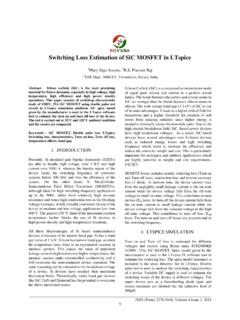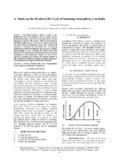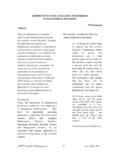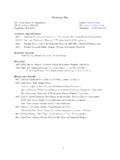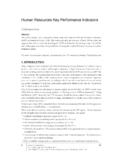Transcription of Performance Indicators for Construction Project
1 ISSN (Print): 2278-8948, Volume-2, Issue-1, 2013 61 Abstract A Performance indicator (PI) is industry jargon for a type of Performance measurement. PIs are commonly used by an organization to evaluate its success or the success of a particular activity in which it is engaged. Sometimes success is defined in terms of making progress toward strategic goals, but often success is simply the repeated achievement of some level of operational goal. Accordingly, choosing the right PIs is reliant upon having a good understanding of important things to the organization. Important things often depend on the department measuring the Performance , the PIs useful to Construction activities are different than the PIs assigned to accounting. Because of the need to develop a good understanding of what is important, Performance indicator selection is often closely associated with the use of various techniques to assess the present state of the Project , and its key activities.
2 These assessments often lead to the identification of potential improvements; and as a consequence, Performance Indicators are routinely associated with ' Performance improvement' initiatives. Performance Indicators associated with Construction projects have got very little attention and somehow there use has been very limited and even limited use is focused on product oriented Indicators . This means that the Indicators are mostly used for review purposes after Project is completed and hence are unable to control the Project .There is a need of a great deal of attention on pre and present or process stage of Construction Project especially for projects in developing countries like India where the adverse conditions are always at the corner including at a preliminary stage or even before the start of a Project .
3 This paper describes the idea behind Indicators and describes some of the very important Indicators regarding the Construction projects and also emphasizes the point of value management as one of the most important Performance indicator in Construction Project . Index Terms Performance indicator, Construction Project , India I. INTRODUCTION Performance Indicators are measures of Project impacts, outputs and inputs that are monitored during Project implementation to assess progress toward Project objectives. They are also used later to evaluate a Project 's success Indicators organize information in a way that clarifies the relationships between Project 's impacts, outcomes outputs and inputs and help to identify problems along the way that can impede the achievement of Project objectives.
4 Key Performance Indicators define a set of values used to measure against. These raw sets of values, which are fed to systems in charge of summarizing the information, are called Indicators . Indicators identifiable as possible candidates for PIs can be summarized into the following sub-categories [1]Quantitative Indicators which can be presented as a number. [2]Practical Indicators that interface with existing company processes. [3]Directional Indicators specifying whether an organization is getting better or not. [4]Actionable Indicators are sufficiently in an organization's control to affect change. [5]Financial Indicators used in Performance measurement and when looking at an operating index. Key Performance Indicators , in practical terms and for strategic development, are objectives to be targeted that will add the most value to the business.
5 These are also referred to as key success Indicators . II. IMPORTANT ASPECTS Performance Indicators (PIs) are ways to periodically assess the performances of organizations, business units, and their division, departments and employees. Accordingly, PIs are most commonly defined in a way that is understandable, meaningful, and measurable. They are rarely defined in such a way such that their fulfillment would be hampered by factors seen as non-controllable by the organizations or individuals responsible. Such PIs are usually ignored by organizations. In order to be evaluated, PIs are linked to target values, so that the value of the measure can be assessed as meeting expectations or not. A. Identifying Indicators of organization Performance Indicators differ from business drivers and aims (or goals). A school might consider the failure rate of its students as a key Performance indicator which might help the school understand its position in the educational community, whereas a business might consider the percentage of income from returning customers as a potential PI.
6 Similarly Construction projects have Indicators like cost, on time completion The key stages in identifying PIs are Having a pre-defined business process (BP). Having requirements for the BPs. Having a quantitative/qualitative measurement of the results and comparison with set goals. Investigating variances and tweaking processes or resources to achieve short-term goals. A PI can follow the SMART criteria. This means the measure has a Specific purpose for the business, it is Measurable to really get a value of the PI, the defined norms Performance Indicators for Construction Project Vyas Gayatri S1, Kulkarni Saurabh S2 1 Assistant Professor, College of Engineering Pune, 2 Post Graduate Student, College of Engineering Pune, 2kulkarnisaurabh88 International journal of Advanced Electrical and Electronics Engineering, (IJAEEE) ISSN (Print): 2278-8948, Volume-2, Issue-1, 2013 62 have to be Achievable, the improvement of a PI has to be Relevant to the success of the organization, and finally it must be Time phased, which means the value or outcomes are shown for a predefined and relevant period.
7 The Construction industry of India is an important indicator of the development as it creates investment opportunities across various related sectors. The Construction industry has contributed an estimated 3,84,282 crore to the national GDP in 2010-11 (a share of around 8%). The sector is labor-intensive and, including indirect jobs, provides employment to more than 35 million people. Hence the Performance analysis of a Construction work is of utmost importance. III. LITERATURE REVIEW- Budget, schedule, and quality are the major goals in Construction projects. A variety of factors determine the success or failure of the achievement of these objectives. Because the present study focuses on Performance Indicators for budget, schedule, and quality Performance of Construction projects, a brief review of related published works is appropriate.
8 Baker et al. (1983) conducted a survey of successful and unsuccessful projects involving manufacturing, Construction , government, services, transportation, and other projects and concluded that there are seven critical factors for Project success. Performance measurement involves the collection and comprehensive analysis of information about various activities, specifically work in place and the corresponding work-hours over a given period of time. Work hours, quantity and productivity are evaluated against the planned or baseline values used in Project estimates (Lin and Shen 2007). In other words, to accurately identify Performance Indicators associated with a Construction process, a base line must first be determined. A historical base line defines an average of past Performance . Knowledge of past Performance gives a reference point to benchmark against which to measure future Performance .
9 Benchmarking aims at comparing the Performance of firms relative to each other, allowing these firms to recognize their weaknesses and strengths and by finding examples of superior Performance , can adjust their policies and practices to improve their Performance (Mohammad et al. 2007). This is also applicable to projects and a base line can be compilations of years of historical data collected on previous projects or a quick measurement of current production prior to initiating a change for improvement. Performance Indicators can either be quantitative results of a Construction process or by quantitative measures such as workers behavior on the job (Cox et al. 2003). Prior to the 1980s, Project Performance was narrowly defined as meeting cost and time objectives, and adhering to a product specification (Bryde 2003).
10 However, research during the 1980s and 1990s aimed at investigating the dimensions of Project success has led to a common agreement that Project success is multidimensional and that different people measure Project success or Performance in different ways and at different times (Ugwu and Haupt 2007). This, therefore, gave rise to different ways of measuring Project Performance . Key Performance Indicators , according to Cox et al. (2003) are compilations of data measures used to assess the Performance of a Construction operation. They are the methods used to evaluate the Performance of a particular task. These evaluations compare the actual and estimated Performance in terms of effectiveness, efficiency and quality in terms of both workmanship and product. In a study by Chan and Chan (2004), a set of Key Performance Indicators (KPI) were developed through a literature review and then subjected to validity test using a set of three case studies.

